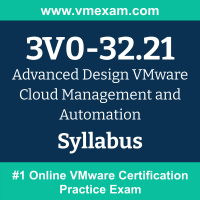 The VMware 3V0-32.21 exam preparation guide is designed to provide candidates with necessary information about the VCAP-CMA Design 2023 exam. It includes exam summary, sample questions, practice test, objectives and ways to interpret the exam objectives to enable candidates to assess the types of questions-answers that may be asked during the VMware Certified Advanced Professional - Cloud Management and Automation Design 2023 (VCAP-CMA Design 2023) exam.
The VMware 3V0-32.21 exam preparation guide is designed to provide candidates with necessary information about the VCAP-CMA Design 2023 exam. It includes exam summary, sample questions, practice test, objectives and ways to interpret the exam objectives to enable candidates to assess the types of questions-answers that may be asked during the VMware Certified Advanced Professional - Cloud Management and Automation Design 2023 (VCAP-CMA Design 2023) exam.
It is recommended for all the candidates to refer the 3V0-32.21 objectives and sample questions provided in this preparation guide. The VMware VCAP-CMA Design 2023 certification is mainly targeted to the candidates who want to build their career in Cloud Management and Automation domain and demonstrate their expertise. We suggest you to use practice exam listed in this cert guide to get used to with exam environment and identify the knowledge areas where you need more work prior to taking the actual Advanced Design VMware Cloud Management and Automation exam.
VMware 3V0-32.21 Exam Summary:
|
Exam Name
|
Advanced Design VMware Cloud Management and Automation (VCAP-CMA Design 2023) |
| Exam Code | 3V0-32.21 |
| Exam Price | $450 USD |
| Duration | 145 minutes |
| Number of Questions | 60 |
| Passing Score | 300 / 500 |
| Recommended Training / Books |
VMware vRealize Suite Lifecycle Manager: Install, Configure, Manage [V8.0] VMware vSphere: Design [V7] |
| Schedule Exam | PEARSON VUE |
| Sample Questions | VMware 3V0-32.21 Sample Questions |
| Recommended Practice | VMware Certified Advanced Professional - Cloud Management and Automation Design 2023 (VCAP-CMA Design 2023) Practice Test |
VMware VCAP-CMA Design 2023 Syllabus:
| Section | Objectives |
|---|---|
| Architecture and Technologies |
- Differentiate between architecting a solution on SaaS vs on-prem (i.e. cloud proxy) - Differentiate between business and technical requirements - Differentiate conceptual, logical and detailed design - Differentiate between Availability, Manageability, Performance, Recoverability and Security (AMPRS) |
| Products and Solutions |
- Understand the design principles of VVD - Understand the design of vRealize Cloud Management solutions - Understand the design of VMware Cloud Foundation |
| Planning and Designing |
- Gather/Analyze requirements- Business/Technical - Determine risks, constraints, and assumptions for a design - Create a Conceptual Design - Create a vRealize Suite Lifecycle Manager Logical Design - Create a VMware Identity Manager Logical Design - Create a vRealize Automation Logical Design - Create a vRealize Operations Logical Design
- Create vRealize Log Insight Logical design
- Create a vRealize Operations Physical Design
- Create vRealize Log Insight Physical Design
- Create a vRealize Automation Tenant Design (Cloud Assembly)
- Create a vRealize Automation Service Catalog Design (Service Broker)
- Determine the vRealize Suite Integrations based on requirements
|
| Installing, Configuring, and Setup | |
| Performance-tuning, Optimization, and Upgrades | |
| Troubleshooting and Repairing | |
| Administrative and Operational Tasks |
